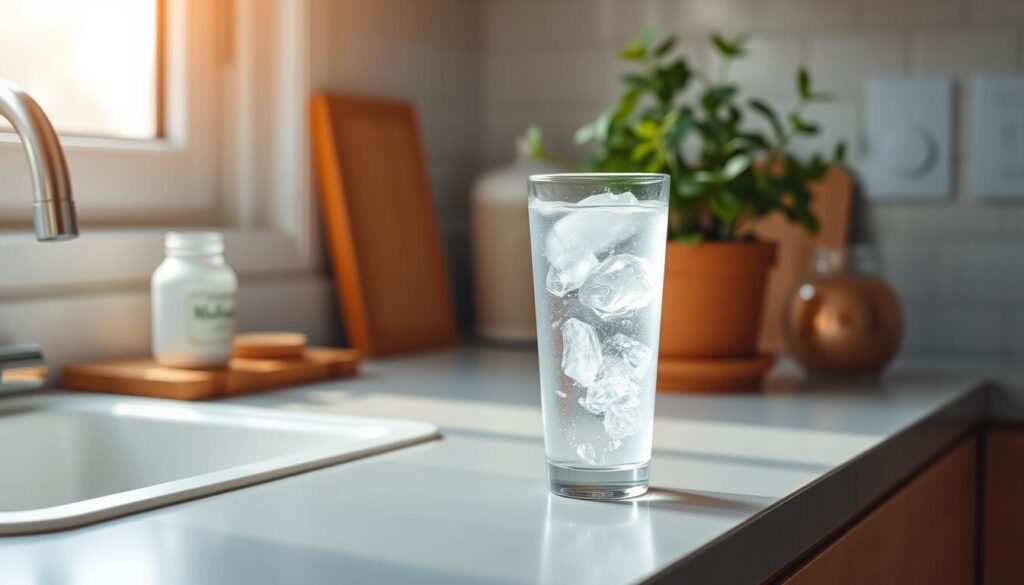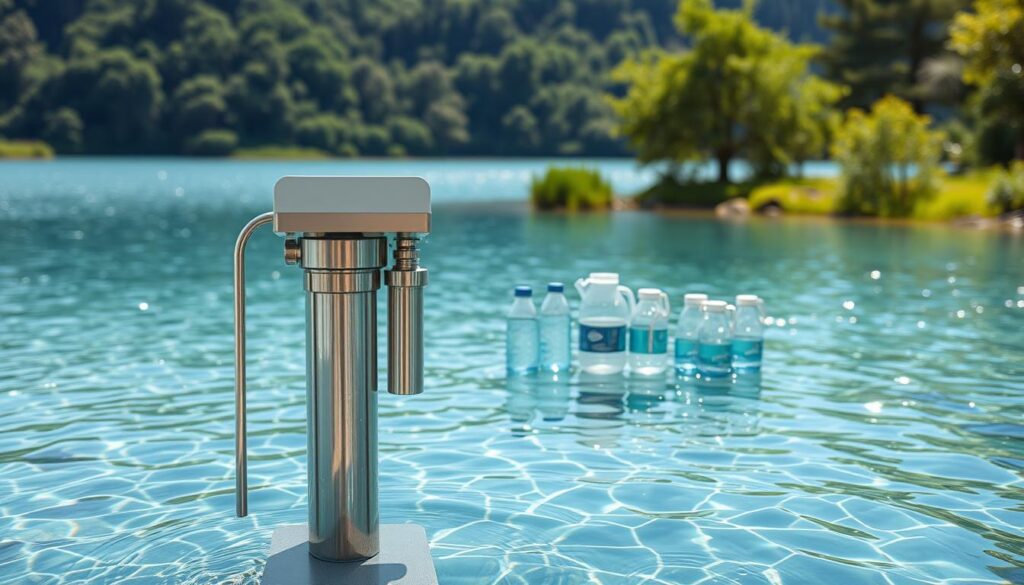As a homeowner, I’ve always looked for ways to save money and help the environment. One great way I found is using a rainwater harvesting system. This lets me collect and store rainwater for different uses around the house, cutting down on my use of city water.
Water conservation techniques like rainwater harvesting are good for the planet and my wallet. In this guide, I’ll share what I’ve learned about rainwater harvesting. You’ll learn from the basics to setting up and keeping your own system running smoothly.
Key Takeaways
- Understand the benefits of rainwater harvesting for homeowners
- Learn the basics of rainwater harvesting systems
- Discover how to install and maintain a rainwater collection system
- Explore water conservation techniques to reduce your environmental footprint
- Find out how rainwater harvesting can lower your water bills
Understanding Rainwater Collection Systems
As a homeowner, learning about rainwater harvesting systems can change how you manage water. It involves catching and storing rainwater from rooftops or other surfaces. This method is a simple yet effective way to save water.
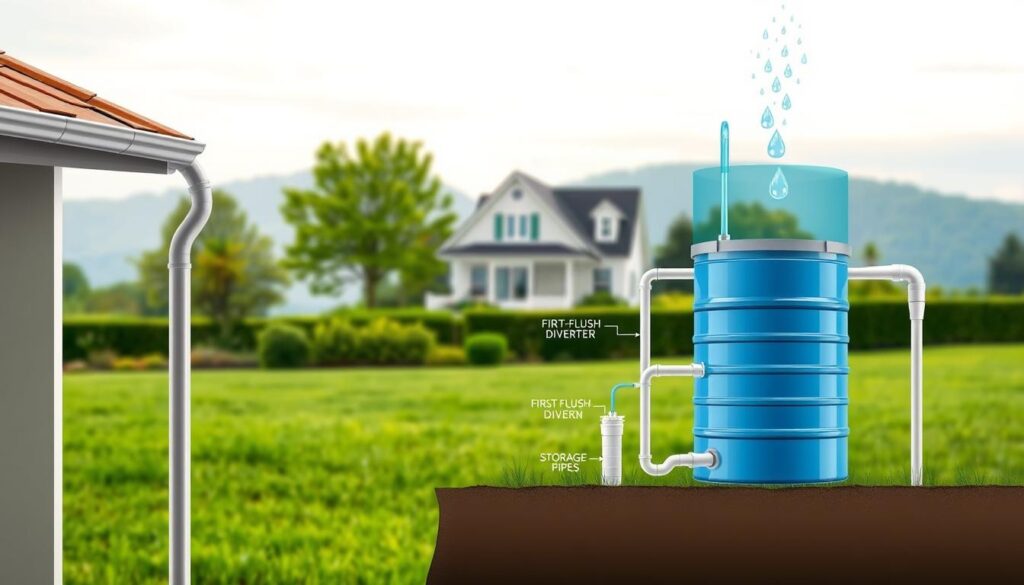
What Is Rainwater Collection?
Rainwater collection means catching and storing rainwater for later use. It’s an old practice that’s becoming more popular as a sustainable water management method. By collecting rainwater, homeowners can use less municipal water, save on water bills, and help the environment.
Benefits of Collecting Rainwater
The advantages of rainwater harvesting are many. It helps reduce stormwater runoff, easing the burden on urban drainage systems and lowering flood risks. Also, collected rainwater can be used for things like watering plants, flushing toilets, and cleaning outside, which cuts down on the need for drinking water.
Collecting rainwater also means lower water bills, as you’re using free water for certain needs. It’s a sustainable way to conserve water and lessen the impact on groundwater.
Common Misconceptions
Despite its benefits, some think rainwater harvesting is too hard or expensive. But, with the right help and resources, it can be easy and affordable to set up.
Another myth is that rainwater isn’t safe to use. While it’s true rainwater might have contaminants, the right collection, storage, and treatment can make it safe for many uses. Knowing this can help homeowners decide to use rainwater harvesting systems.
Planning Your Rainwater Harvesting System
Before you start setting up a rainwater harvesting system, planning is key. This step makes sure your system fits your needs and property well.
Assessing Your Property's Potentials
To figure out if your property can collect rainwater, look at your roof’s size and material. Also, check the local rainfall patterns. A bigger roof can hold more water, but the material must be safe for collection.
For example, asphalt shingle roofs are okay for collecting rainwater. But, avoid roofs with harmful materials like lead. Knowing your area’s average rainfall helps estimate how much water you can collect.
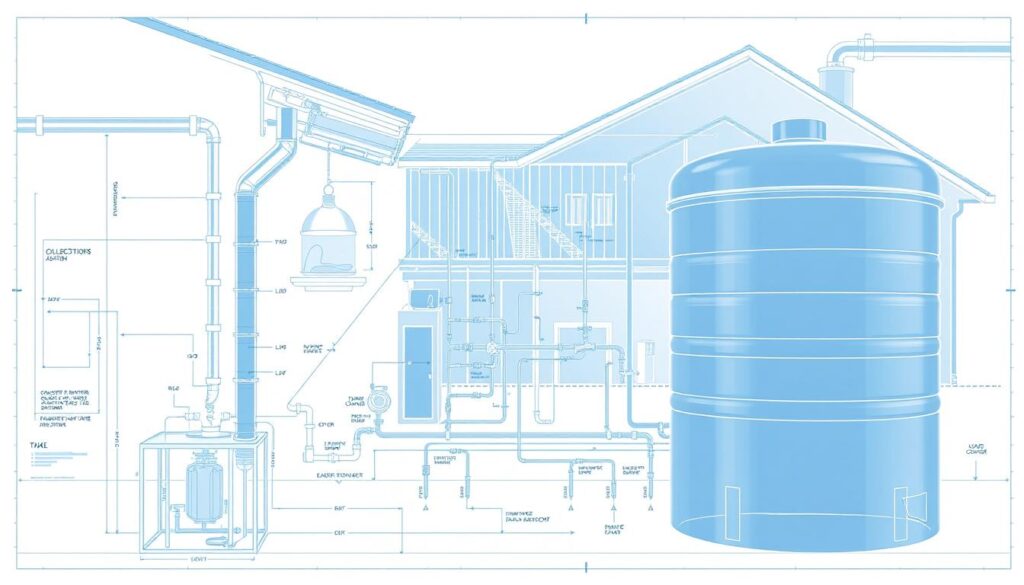
Choosing the Right Location
The spot for your rainwater tank is very important. It should be in the shade to prevent algae and close to a downspout for less piping. Also, pick a spot that’s easy to get to for upkeep.
Make sure the area is flat and can handle the tank’s weight when full. This is key for your system’s success.
Materials You Will Need
You’ll need a tank, gutters, downspouts, and a filter for your system. The materials you choose affect how well and long your system lasts.
| Component | Material Options | Considerations |
|---|---|---|
| Storage Tank | Plastic, Steel, Concrete | Durability, Cost, Maintenance |
| Gutters and Downspouts | Aluminum, Vinyl, Steel | Durability, Corrosion Resistance |
| Filtration System | Mesh Screens, Sedimentation Tanks | Effectiveness, Maintenance Needs |
By planning well, you can make a great DIY rainwater collection system. This includes checking your property, picking the best spot, and choosing the right materials.
Components of a Rainwater Collection System
Knowing the parts of a rainwater collection system is key for homeowners. It helps them use rainwater effectively. A good system gathers and stores rainwater for different uses. It works well when all parts work together.
Gutters and Downspouts
Gutters and downspouts are vital for directing rainwater to the storage tank. Efficient gutters handle the water from the roof. Downspouts make sure this water goes to the tank. It’s important to clean gutters often to avoid blockages.
Rain Barrels and Tanks
Rain barrels and tanks hold the collected rainwater. The choice depends on space, rainfall, and water use. Rain barrels are good for small gardens or decoration. Tanks hold more water, perfect for bigger irrigation or household needs.
Filtration and Treatment Options
Filtration and treatment are key to safe rainwater use. Filtration systems can be simple or complex. They remove debris and contaminants. Depending on use, UV treatment or chemical disinfection might be needed for safe water.
Installation Process for Homeowners
Setting up a rainwater harvesting system is doable with some DIY know-how and knowledge of local rules. It involves several important steps to make sure the system works well and follows local laws.
DIY Installation Steps
For those who enjoy DIY projects, installing a rainwater system can be fulfilling. First, you need to assess your property’s roof catchment area to see how much rainwater you can collect. Then, pick the right gutters and downspouts to direct water into your tanks or barrels.
Next, set up the gutters and downspouts, connect them to the tanks, and make sure they’re clean. It’s also key to place the tanks on a flat surface and secure them to avoid tipping.
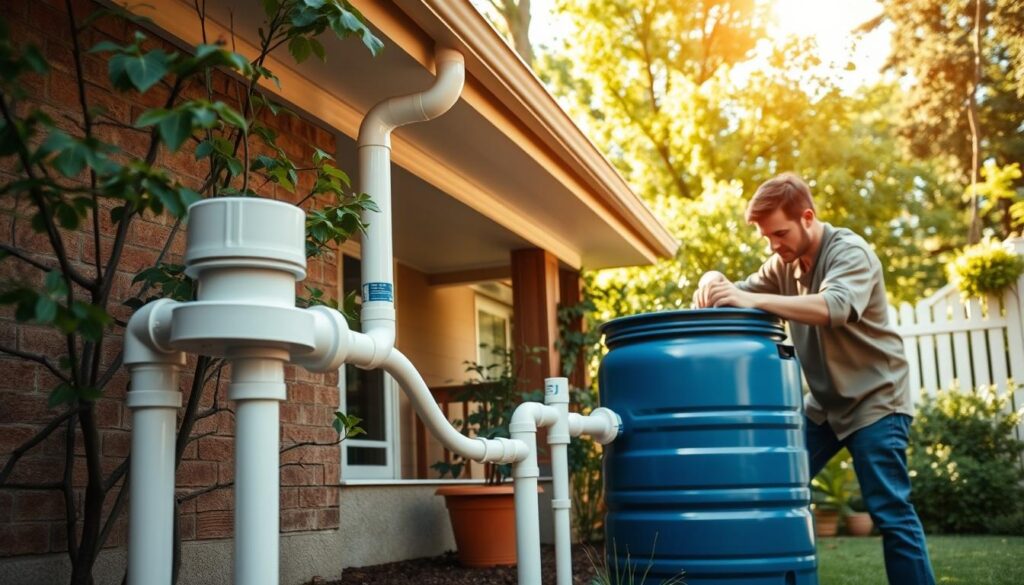
When to Hire a Professional
While many can handle DIY installation, some jobs are better left to the pros. If your roof is complex or you’re setting up a big system, a pro can ensure it’s done right.
Experts can also help make your system more efficient and guide you through local rules and permits.
Local Codes and Regulations
Before starting your rainwater project, learn about local rules on collecting rainwater. Some places have specific rules for designing, installing, and keeping rainwater systems, including permits and checks.
Knowing and following these rules helps avoid fines or problems with your system. It’s smart to talk to local authorities or a pro to make sure your system meets sustainable water management standards.
Maintaining Your Rainwater Collection System
Regular maintenance is key to a successful rainwater collection system. To get the most out of your investment, keep your system in top shape.
Routine Inspections
Routine inspections are vital to catch issues early. I suggest checking your system at least twice a year, or after big weather events.
- Inspect gutters and downspouts for debris and damage.
- Check the rain barrels or tanks for signs of wear or leakage.
- Ensure that the filtration system is functioning correctly.
Cleaning and Preventative Measures
Cleaning your rainwater collection system regularly is key to prevent contamination. This includes:
- Cleaning gutters and downspouts to prevent clogging.
- Flushing the rain barrels or tanks periodically.
- Replacing filters in the filtration system as needed.
Also, consider adding screens to keep out debris and mosquitoes.
Troubleshooting Common Issues
Even with regular maintenance, issues can pop up. Knowing how to troubleshoot common problems helps you fix them fast.
- Clogged gutters or downspouts: Check for debris and clean as necessary.
- Leaks in the system: Inspect connections and seals, and repair or replace as needed.
- Contaminated water: Check the filtration system and consider additional treatment options if necessary.
By following these maintenance tips, your rainwater harvesting system will stay effective. It will continue to provide reliable water for years.
Tips for Maximizing Rainwater Collection
To get the most out of your rainwater collection system, follow a few key strategies. This includes optimizing your roof, making seasonal adjustments, and using efficient irrigation methods.
For more information on rainwater harvesting, visit Robin Greenfield’s website. It offers detailed insights into sustainable water management.
Optimizing Roof Surface Area
Optimizing your roof surface area is key to maximizing rainwater collection. Make sure your roof is clean and use a material that doesn’t contaminate the water. A clean, suitable roof can greatly improve the quality and amount of collected rainwater.
A well-maintained roof is essential for effective rainwater harvesting. Regular checks can spot issues like debris or damaged materials, which can be fixed quickly.
Seasonal Adjustments and Strategies
Seasonal adjustments are vital for maximizing rainwater collection. In dry periods, conserve water and increase storage capacity. During heavy rain, ensure your system can handle excess water without overflowing.
- Regularly check your gutters and downspouts to ensure they work well.
- Adjust your irrigation schedule based on weather.
- Consider using drip irrigation or soaker hoses to reduce water waste.
Using Soaker Hoses and Drip Irrigation
Soaker hoses and drip irrigation can greatly reduce water waste. They deliver water directly to plant roots, cutting down on evaporation and runoff.
“Drip irrigation is a highly efficient method of watering plants, reducing water loss by up to 50% compared to traditional sprinkler systems.”
By using these strategies, you can maximize your rainwater collection. This helps with sustainable water management.
How to Use Collected Rainwater
Collected rainwater is very useful. You can use it for irrigation and household chores. This helps with sustainable water management.
Landscape Irrigation
Using rainwater for landscape irrigation is common. It saves potable water and cuts down on municipal water use. A dedicated irrigation system is best for this.
This method is efficient, even when it’s dry. Rainwater lacks many chemicals found in tap water. It’s good for plants.
Outdoor Cleaning and Maintenance
Rainwater is great for outdoor cleaning. You can wash cars, clean furniture, and keep your home’s exterior clean. This saves potable water, which is good for water conservation techniques.
- Washing cars and outdoor equipment
- Cleaning patios, driveways, and sidewalks
- Rinsing outdoor furniture and decorations
Indoor Uses and Considerations
For indoor use, rainwater can flush toilets and run washing machines. But, it needs proper treatment and filtration first. A treatment system with filtration and UV treatment is key.
Using rainwater indoors requires careful water quality and safety checks. Make sure your system has the right treatment and filters. This prevents contamination.
Using rainwater in different ways boosts your system’s efficiency. It helps with sustainable water management.
Understanding the Legalities of Rainwater Harvesting
The rules for rainwater harvesting change a lot from place to place. It’s really important to know what’s allowed in your area.
Looking into rainwater harvesting systems shows that it’s not just about collecting water. It’s also about following the law.
State Regulations in the U.S.
In the U.S., laws about rainwater harvesting are not the same everywhere. Each state has its own rules and guidelines.
- Some states, like Colorado and Utah, are more open to rainwater harvesting.
- Other states might have stricter rules, needing permits or limiting how much water you can collect.
It’s key to know your state’s rules before setting up a rainwater harvesting system.
Permits and Restrictions
Getting the right permits is a big part of setting up a rainwater harvesting system.
Local authorities usually ask for permits before you can start collecting rainwater.
- Find out what your local water authority needs from you.
- Make sure your system meets local building codes and rules.
Environmental Considerations
Rainwater harvesting is good for saving water, but we must think about the environment too.
The materials for your system should be good for the planet. It should also stop mosquitoes and other environmental problems.
By following the laws and thinking about the environment, homeowners can make sure their rainwater harvesting systems work well and are good for the planet.
Resources for Further Learning
To learn more about rainwater harvesting, many resources are available. If you want to dive deep into the topic, there are books and guides. They cover rainwater collection and DIY systems in detail.
Educational Materials
Books and guides on rainwater harvesting are full of useful information. They cover everything from the basics to advanced techniques. You can find them online or at your local library.
Community Engagement
Online communities and forums are great for sharing experiences and asking questions. They’re perfect for learning from others who have set up DIY systems. For more on safe drinking water and rainwater harvesting, check out this guide.
Practical Training
Workshops and local classes offer hands-on learning. They teach you how to design and maintain rainwater systems. These classes are great for learning how to use rainwater on your property.
FAQ
What is the primary purpose of a rainwater harvesting system?
A rainwater harvesting system collects and stores rainwater. It helps reduce the need for municipal water. It also eases the burden on urban drainage systems.
How do I determine the suitable size of a rainwater storage tank for my property?
To find the right tank size, look at your property’s rainwater collection ability. Consider your roof’s size, material, and local rain patterns.
What are the benefits of using rainwater for landscape irrigation?
Using rainwater for irrigation cuts down on municipal water use. It also reduces stormwater runoff. Plus, it’s a free, sustainable water source for plants.
Can I use collected rainwater for indoor purposes, such as flushing toilets or running washing machines?
Yes, you can use rainwater indoors. But, it must be treated and filtered first to make it safe.
What are the key components of a rainwater collection system?
A rainwater system includes gutters, downspouts, and tanks. It also has filters and treatment options.
How often should I inspect and maintain my rainwater harvesting system?
Regular checks and upkeep are key for your system’s life and performance. Look for issues during routine inspections.
Are there any local regulations or permits required for installing a rainwater harvesting system?
Yes, know the local rules and get the needed permits. This ensures your system meets state standards.
How can I optimize my roof surface area for rainwater collection?
To get the most rainwater, keep your roof clean and use the right material. This maximizes collection.
What are some strategies for maximizing rainwater collection during dry periods?
During dry times, increase your storage capacity. This helps collect more rainwater.
Can I install a rainwater harvesting system myself, or should I hire a professional?
DIY installation is possible, but sometimes a pro is better. This is true if you’re unsure about local rules or complex designs.
What are some common uses for collected rainwater?
Rainwater is great for irrigation, washing cars, and cleaning outdoor areas. It’s also good for flushing toilets and running washing machines.


